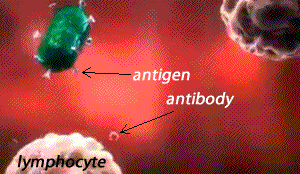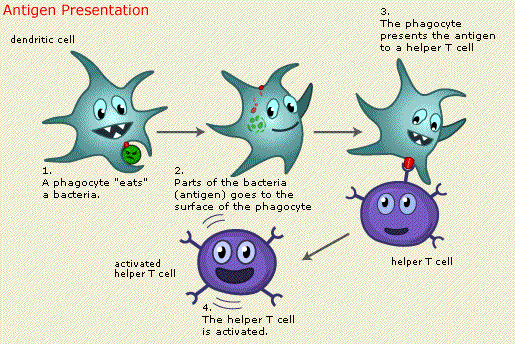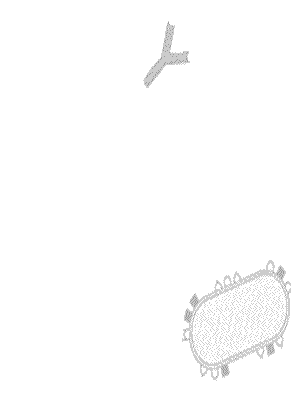The Immune System - in More Detail (for junior science)
Introduction
The immune system is one of nature's more fascinating inventions. With ease, it protects us against billions of bacteria, viruses, and other parasites. Most of us never reflect upon the fact that while we hang out with our friends, watch TV, or go to school, inside our bodies, our immune system is constantly on the alert, attacking at the first sign of an invasion by harmful organisms.
The immune system is very complex. It's made up of several types of cells and proteins that have different jobs to do in fighting foreign invaders. In this section, we'll take a look at the parts of the immune system in some detail. It is assumed you have some background knowledge of the immune system.
The Complement System
The first part of the immune system that meets invaders such as bacteria is a group of proteins called the complement system. These proteins flow freely in the blood and can quickly reach the site of an invasion where they can react directly with antigens - molecules that the body recognizes as foreign substances. When activated, the complement proteins can
- trigger inflammation
- attract a special type of white blood cells that ingests solids called a phagocyte.
- coat invading cells with proteins (antibodies) to make them more recognisable to other phagocytes and therefore more likely to be ingested.
- insert proteins in the bacterial cell wall that causes the cell to burst.
This is a group of immune cells specialised in finding and "eating" bacteria, viruses, and dead or injured body cells. There are three main types, the granulocyte, the macrophage, and the dendritic cell.
Lymphocytes - T cells and B cells
White blood cells called lymphocytes originate in the bone marrow but migrate to parts of the lymphatic system such as the lymph nodes, spleen, and thymus. There are two main types of lymphatic cells, T cells and B cells. These lymphocytes carry antibodies on their surface that may fit the antigen molecules on the surface of a bacteria or even a virus. These antibodies are very specific and each can match only one type of antigen in a lock and key manner. To understand the antibodies, think of a key that fits into a specific lock. It is only this unique combination that will trigger the lock to open.
The lymphocyte cells travel through the body until they find an antigen of the right size and shape to match their specific antibodies. It might seem limiting that the antibodies of each lymphocyte cell can only match one specific type of antigen, but the body makes up for this by producing so many different lymphocytes that the immune system can recognise nearly all invaders.

T cells come in two different types, helper cells and killer cells. They are named T cells after the thymus, an organ situated under the breastbone. T cells are produced in the bone marrow and later move to the thymus where they mature before travelling to all the lymph nodes in the body. This is differet to B cells that mature in the bone marrow and travel to the lymph nodes.

Helper T cells are the major driving force and the main regulators of the immune defense. Their primary task is to activate B cells and killer T cells, however, the helper T cells themselves must be activated. This happens when a macrophage or dendritic cell, which has eaten an invader, travels to the nearest lymph node to present information about the captured pathogen. The phagocyte displays an antigen fragment from the invader on its own surface, a process called antigen presentation. When the receptor of a helper T cell recognizes the antigen, the T cell is activated. Once activated, helper T cells start to divide and to produce proteins that activate B and T cells as well as other immune cells.
Killer T cells are specialised in attacking cells of the body infected by viruses and sometimes also by bacteria. This is known as a cell mediated immune response. They can also attack cancer cells. Killer T cells have receptors that are used to search each cell that it meets. If a cell is infected, it is swiftly killed. Infected cells are recognised because tiny traces of the intruder, antigen, can be found on their surface.
T-memory cells are also produced and have a long life span. When the body encounters an antigen for the second time, memory T cells can reproduce to mount a faster and stronger immune response than the first time the immune system responded to the antigen. This behaviour significantly limits the damge the antigen can do the second time around.
View the video on the right.
The video refers to the adaptive immune system. This is made up of two parts the:
- humoral immunity which involves the production of antibody molecules by B-lymphocytes in response to an antigen,
- cell mediated immunity which is mediated by T-lymphocytes and involves the production
of a range of defense cells such as cytotoxic T-lymphocytes and activated macrophages.
1) How does the surface of a cell change after it is infected?
2)
How do T-cells recognise an antigen infected cell?
3) Describe the steps that follow when a T-cell finds and binds to an infected cell.
4) How are killer T-cells formed and how do they act to defend the body?
5) What is the function of a memory cell?
B Cells
The B lymphocyte cell searches for antigen matching its receptors. If it finds such antigen it connects to it, triggering a cascade of reactions signal inside the cell that prime it ready for action. All it needs are certain proteins produced by helper T cells to become fully activated and commence rapid division. When this happens, the B cell starts to divide to produce clones of itself, during which two new cell types are created, plasma cells and B memory cells.
The plasma cell is specialized in producing a specific protein, called an antibody, that will respond to the same antigen that matched the B cell receptor. Antibodies are released from the plasma cell so that they can seek out intruders and help destroy them. Plasma cells produce antibodies at an amazing rate and can release tens of thousands of antibodies per second.
When the Y-shaped antibody finds a matching antigen, it attaches to it. The attached antibodies serve as an appetizing coating for eater cells such as the macrophage. Antibodies also neutralize toxins and incapacitate viruses, preventing them from infecting new cells. Each branch of the Y-shaped antibody can bind to a different antigen, so while one branch binds to an antigen on one cell, the other branch could bind to another cell - in this way pathogens are gathered into larger groups that are easier for phagocyte cells to devour. Bacteria and other pathogens covered with antibodies are also more likely to be attacked by the proteins from the complement system.


The Memory Cells are the second cell type produced by the division of B cells. These cells have a prolonged life span and can thereby "remember" specific intruders. T cells can also produce memory cells with an even longer life span than B memory cells. The second time an intruder tries to invade the body, memory cells help the immune system to activate much faster. The invaders are wiped out before the infected human feels any symptoms. The body has achieved immunity against the invader.
The cartoon on the right sumamrises the process.
6) What is a vaccine (research this question)
7)
How does a vaccine work?
8) A foreign molecule tha can activate the immune system is known as an
9) Antibodies are produced in cells called
10) Complement proteins work by
11) Describe, in simple terms, what takes place when a bacterium enters the body and activates the immune system.
12) Cytotoxic or Killer T-lymphocytes
13) B and T lymphocytes are produced in the
14) What cells mature as they move around the body from thymus to lymph nodules?
15) Which cells phagocytise antigen-bearing cells and bind their proteins to its membrane surface?
16) Which of the following undergoes non-specific attack of antigens?